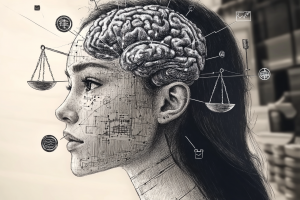The Armenian Lawyers Association and Iravaban.net‘s innovative series “LegalTech Armenia” aims to uncover the path of convergence between law and technology. Within this series, we present how the digital revolution is reshaping the legal landscape in Armenia and worldwide. The project’s conceptual author and leader is Karen Zadoyan, President of the Armenian Lawyers Association.
In the ninth article of the innovative series, “Big Data in the Judicial System,” we will reveal how big data and cutting-edge analytical tools are transforming judicial operations and decision-making processes.
Iravaban.net‘s journalists and experts, equipped with the latest technological tools, including advanced applications of artificial intelligence, will present analyses, exclusive interviews, and engaging stories, prepare photographs and infographics. We will uncover how data science, big data, and machine learning are transforming legal practice, the judicial system, and legislative processes.
Introduction
In this era of big data, the judicial system stands at the precipice of unprecedented transformation. Technological advancements, particularly in artificial intelligence and machine learning, are unlocking new possibilities to enhance judicial efficiency and the administration of justice. This article explores how big data is revolutionizing judicial processes and examines the prospects for Armenia in this dynamic field.
In leading international law schools, technology education has become paramount. Stanford Law School, for instance, is renowned for its pioneering role in the convergence of technology and law, offering a comprehensive array of courses and programs focused on this cutting-edge domain.
CodeX: Stanford Center for Legal Informatics: CodeX: Stanford Center for Legal Informatics is an interdisciplinary laboratory that explores how technologies can improve the legal system. The center collaborates with lawyers, entrepreneurs, engineers and researchers to develop innovative solutions for the legal field.
- Legal document management
- Legal infrastructure development
- Computational law advancements
1. The Transformative Role of Big Data in the Judicial System
Big data is revolutionizing judicial processes in several key areas:
- Predictive Analytics for Judicial Decisions: Advanced AI algorithms analyze historical decisions to forecast potential outcomes for new cases.
- Comprehensive Case Analysis: Big data analytics identify intricate patterns and trends across numerous court cases.
- Judicial System Optimization: Data-driven insights help pinpoint and eliminate inefficiencies within the system.
- Strategic Resource Allocation: Big data facilitates more effective distribution of judicial resources.
A prime example is the COMPAS (Correctional Offender Management Profiling for Alternative Sanctions) system, employed in U.S. courts to assess recidivism risk using sophisticated data analysis.

The image symbolizes the analysis of big data in the judicial system.
2. The Multifaceted Advantages of Big Data Integration
The incorporation of big data brings numerous benefits to the judicial system:
- Enhanced Decision-Making Efficiency: Automated analysis enables swift processing of vast information volumes.
- Heightened Objectivity: Data-centric decisions mitigate the influence of subjective factors.
- Unparalleled Transparency: Data analysis techniques identify and rectify inconsistencies in judicial rulings.
- Optimized Resource Utilization: Big data analytics drive smarter allocation of judicial system resources.
A groundbreaking example is Estonia’s 2019 introduction of the “Robot Judge” pilot program for small claims (up to €7,000). This innovative system analyzes submitted documents and proposes draft decisions for human judge review, significantly expediting judicial processes and alleviating court backlogs.

The image symbolizes the advantages of big data in the judicial system.
3. Navigating Challenges and Ethical Considerations
The integration of big data in judicial systems raises important challenges and ethical considerations:
- Robust Personal Data Protection: Ensuring ironclad security for sensitive information is paramount.
- Mitigating Algorithmic Bias: AI systems must be carefully designed to avoid perpetuating or amplifying existing social inequalities.
- Upholding Transparency and Accountability: The AI decision-making process must remain transparent and comprehensible.
- Preserving the Human Element: Striking the right balance between technological advancement and human judgment is crucial.
For instance, AI systems often require vast datasets to function effectively, raising critical concerns about data privacy and security. Law firms must exercise extreme caution when processing confidential client information through AI systems. The European Union’s General Data Protection Regulation (GDPR) sets stringent requirements for personal data processing, which must be meticulously considered in the design and implementation of AI systems in the legal sector.

The image symbolizes the ethical issues of using big data in the judicial system.
4. Armenia’s Promising Horizon
Armenia stands at the cusp of a transformative journey in implementing big data and AI within its judicial system:
- Current Landscape: The digitization of Armenia’s judicial system is in its developmental stages, presenting immense opportunities for growth and innovation.
- Emerging Opportunities:
- Comprehensive digitization and enhanced accessibility of judicial data
- Automation of judicial decision analysis for improved consistency and efficiency
- Significant boost in overall judicial system effectiveness
- Key Challenges to Address:
- Overcoming limitations in technical and financial resources
- Developing a skilled workforce through comprehensive training programs
- Adapting the legislative framework to accommodate technological advancements
Karen Zadoyan, President of the Armenian Lawyers’ Association, shared his insights with Iravaban.net:
“Integrating big data and AI into Armenia’s judicial system demands a multifaceted approach. Our primary focus is on digitizing the judicial decision database and ensuring machine readability. This crucial step will pave the way for implementing advanced natural language processing (NLP) algorithms, enabling automated analysis of legal precedents and the creation of predictive models. Concurrently, we’re developing comprehensive AI ethics guidelines to govern the use of AI in judicial decision-making. Finally, we’re rolling out an extensive training program for judges and lawyers, covering big data analysis and AI fundamentals. The Association’s vision is to create a cutting-edge system where technology serves justice while steadfastly preserving human rights and ensuring transparency in legal decision-making processes.”

The image symbolizes the prospects of using big data in the RA judicial system.
Conclusion
The integration of big data and AI in judicial systems presents unprecedented opportunities to enhance the quality, speed, and transparency of justice administration. However, this technological revolution must be approached with due caution and ethical consideration. By adeptly following global trends and cultivating its unique capabilities, Armenia has the potential to emerge as a regional leader in judicial system digitization.
The synergistic collaboration among legal professionals, technology experts, and policymakers is crucial in fostering an environment where big data and AI can be leveraged effectively and responsibly within the judicial framework. This concerted effort will not only elevate the administration of justice but also contribute to the creation of a more equitable, transparent, and trustworthy judicial system for all.

The image symbolizes the future of big data and AI in the judicial system.
Previewing Our Next Article
Don’t miss the eighth article in the innovative series “LegalTech Armenia” by the Armenian Lawyers Association and Iravaban.net: “Automation of Legal Services” We’ll explore how cutting-edge technological solutions are reshaping legal service delivery and unveiling new horizons for legal professionals.
Our upcoming article will delve into how artificial intelligence, machine learning, and other advanced technologies are revolutionizing the legal services landscape. We’ll examine the application of automated systems in legal document creation, research, case management, and client services. Our discussion will highlight how automation is dramatically increasing the efficiency, accessibility, and quality of legal services.
Prepare to witness the transformation of legal practice and discover the essential skills future lawyers will need to thrive in this new era. We’ll also analyze the impact of these changes on Armenia’s legal market and discuss strategies for local lawyers and law firms to adapt and excel in this evolving landscape.
Stay tuned to our publications and join us in exploring the exciting future of law!

The image symbolizes the automation of legal services.
The main image of the article symbolizes the balance between big data and human oversight in the future judicial system.


















